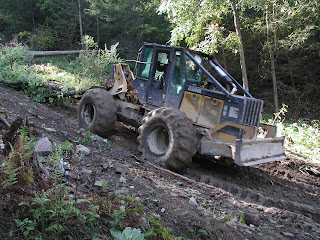I thought my
readers might enjoy this news story printed online for the Tribune Review,
Sunday, November 20, 2016. It was sent
to me by a colleague of mine. It is essentially the same conversation I was
having with folks at a Sustainable Forestry Initiative logger training course
on Sustainable Harvesting Practices just this past fall. If it’s in the news, it must be the best way
of doing things! Right? Give it a read and listen to the video and
let us know what you think. Maybe we
could change the title to something more fitting.
Be sure to
contrast this article with the post by Dan Pubanz from April 27, 2016 entitled “Why the Forestry Profession Should Harshly Criticize High-Grading.” Also, if you
haven’t already red it, be sure to read the article by Dr. Jim Finley posted on
June 21, 2016 entitled “Describing Sustainable Timber Harvesting: What do Words Mean?”
A succession
of loud snaps from crashing limbs are followed by a final thud as a crew of
Amish loggers cut century-old hardwood above Route 56 in Lower Burrell. Although
youth football fans who regularly line Flyers Field might not consider the
surrounding hillside a forest, to a forester, the heavily wooded area certainly
qualifies. And the mature hardwood trees are ripe for select cutting.
It's a
common practice, as Pennsylvania is the largest producer of hardwood lumber in
the nation, according to the state's Department of Conservation and Natural
Resources' Bureau of Forestry. The commonwealth's $20 billion per year forest
products industry employs about 100,000 Pennsylvanians.
“Any forest
is a large garden; you pick the mature fruit,” said Tom McQuaide of Torrance, a
consulting forester for Pennsylvania Forest Management timber and log sales. He
is contracted to cut and sell the logs, taking bids from sawmills throughout
the state.
The
selective cutting of hardwood is a common way to harvest some mature trees and
open up the canopy for younger upstarts, he said. “We don't like to waste
them,” he said. “Overly mature trees are rotted inside.” McQuaide was hired by
a private landowner to selectively cut on the crown of the hill above Flyers
Field along Route 56 in Lower Burrell. They limited their activities so the
cuts wouldn't change the view at the field.
A pile of
red oak, basswood, white ash, hard maple and other logs sat in a staging area
near Route 56. “We cut some of the nicest hardwood timber in the world,”
McQuaide said. Jeff Woleslagle, spokesman for the state forestry department,
agreed: “While the forests of Pennsylvania grow a variety of hardwoods, its
cherry and oak are truly world class.”
McQuaide
pointed to a red oak log. It's in great condition, with tight annual rings in
the washed-out, red center. “This will go into furniture — a table or cabinet,”
McQuaide said. No one will know for sure until the giant logs are cut
lengthwise at a sawmill, then inspected for quality.
But before
then, there's a lot of work for McQuaide and his crew as they take down the
trees he marked beforehand. The Amish workers cut and dragged the logs with a
skidder outfitted with chains on its front tires to conquer the steep terrain. Nathan
Barrett, a timber harvester from Dayton, Armstrong County, carefully sharpened
the teeth on the 20-inch bar of his chain saw.
The oldest
tree he felled in the last week at the site was a 150-year-old red oak. Before
he cut a 50-foot hard maple, he read the layout of the forest, such as the
nearby slim cherry trees to find the path of least resistance and safety.
As Barrett
checked out the direction of a cut and fall, McQuaide said, “You can drop it
across the road and top it. That's where it wants to go.” With a loud splinter,
the oak fell predictably into the cherries, then to the forest floor. After a
few weeks of cutting this month, the fruits of the crew's labor were a little
more than 100 trees over 25 acres. That will translate into 60,000 board feet.
Mary Ann
Thomas is a Tribune-Review staff writer. She can be reached at 724-226-4691 or
mthomas@tribweb.com.



